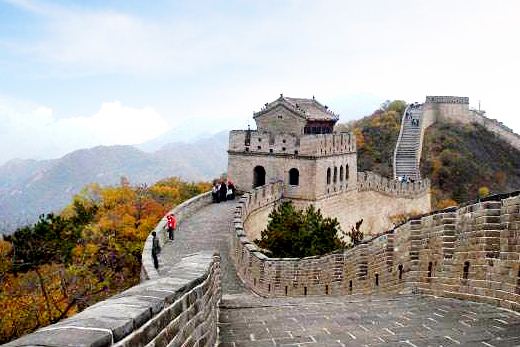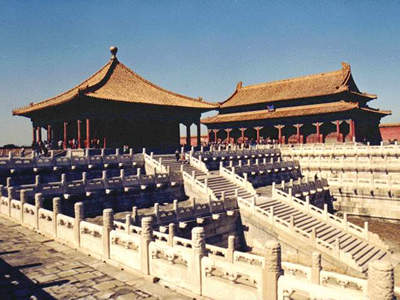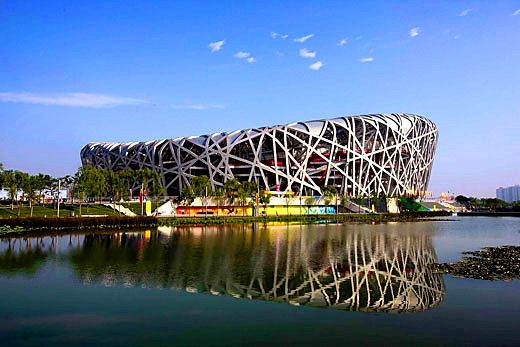The museum building, topped with a rectangular roof that extends over the edge of the edifice like a futuristic mortarboard cap, is an amazing experiment in geometric fusion. It is one among the first structures in the city to attempt a marriage between ancient and modern forms. Expanding out of the shiny science-fiction exterior we see a bronze-like cylindrical 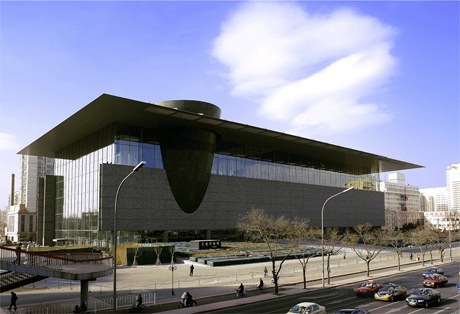 feature that represents the ancient bronze culture of Shang Dynasty China.
feature that represents the ancient bronze culture of Shang Dynasty China.
Construction on the museum, whose collection was once held at the ConfuciusTemple near the Yonghegong Lamasery, began in December 2001. At a cost of 1.23 billion yuan (US$149 million) its stainless-steel construction incorporates a state-of-the-art solar photovoltaic system that is expected to deliver more than 363,000 kilowatt-hours of energy annually.
The museum's lobby is stunning. The "Shang allusion" comes crashing down at an angle into the middle of a vast 2,000-square-metre atrium. Plenty of glass and steel adorn the structure, but there are many traditional Chinese details throughout such as the bronze-like patterns found on the floors of elevators, the cloisonné-looking archway, named Jingde Street, opposite the entrance. Even the tablecloth in the underground restaurant is embroidered with Chinese folk art.
The museum's 30,000-square-metres of exhibition space are dedicated to presenting a complete picture of Beijing's history, architecture and culture. Ample space for the 5,622 items currently on display allow excellent viewing and the museum can easily accommodate its expected 2,000 daily visitors.
The museum will initially have 13 themed exhibitions. During its trial opening, the public an view ten permanent exhibitions, including an exhibition of calligraphy, Buddhist art, Peking Opera, jade and displays concerning the capital city's modernization. Two visiting exhibitions are also on display: a collection of works by Chinese artist Qi Baishi, on loan from the NationalArt Museum, and a gorgeous set of gold and silver utensils from the Forbidden City.
Of special interest is an exhibition of Beijing's culture and history on the second floor that portrays the historical process through which Beijing rose from primitive settlements to become dynastic political centres and, finally, the national capital of China and an international metropolis.
The 500,000-year-old Peking Man relics are followed by extensive displays from imperial dynasties that are explained with well-written bilingual descriptions. Because each Chinese imperial court excelled in writing meticulous histories of each epoch, the museum has been able to compile detailed maps from as early as the 11th century BC concerning transport routes and even the exact movement of the Zhou armies in finally defeating Shang kings.
Among the foremost artefacts in the exhibition are bronze He and Lei pots from the mid 11th century to mid-10th century BC. These artefacts serve as proof that modern day Beijing was a kingdom annexed by Zhou Dynasty Emperor Wu. Engravings on water vessels in the museum reveal that the Yan territory, with its capital at Yuji, was distributed to the emperor’s brother in a feudal manner.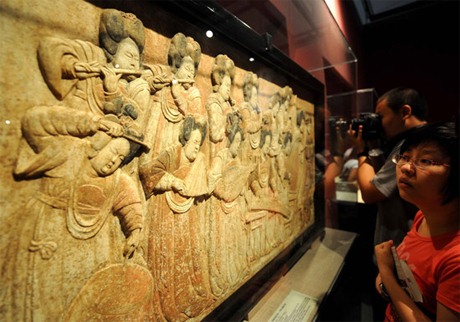
Also from the same period, the museum houses a large and ornate Ding Tripod. This is the largest and heaviest bronze vessel from the Shang or Zhou dynasties ever unearthed in Beijing. The container was used for ceremonies and carries an inscription detailing the history of the Yan kingdom.
Further along in the same exhibition, one of the top three artefacts held by the museum is a robe from the time of the reign of Qing Emperor Qianlong. The dragon robe is embroidered with golden thread that details the "Twelve Ornaments," including the sun, moon, stars and fire. The robe was worn by the emperor for the grandest of ceremonies only, and it is in excellent condition.
Visitors may want to observe that while following the exhibition route, there will be a time when they find display cabinets on their left and pictures and dates, a timeline, adorning a wall on their right. Soon you realise that the pictures on the right correspond to a range of world events. You will see that by the time of Aristotle, Beijing had become the Yan's capital and had taken the name of Yanjing.
Eventually the culture and history exhibition ends in a room where simultaneous video montages from the founding of the People's Republic in 1949 are shown. If you have been in China for any length of time, the films are not new. However, the ambitious display has been designed so that you are engulfed in the footage that attempts to recreate the real atmosphere.
On the fourth floor, there is an exhibition dedicated to a huge array of delicate porcelain, the highlight of which is a blue and white tablet engraved with a map of an imperial porcelain-making factory from the late Qing Dynasty. The tablet details the whole porcelain-making procedure in Jingdezhen, where the imperial court set up an administrative office to manage porcelain production during the Yuan, Ming and Qing periods.
A beautifully carved double vase and a cloisonné vase are among the many striking pieces in the porcelain exhibition. The first, a blue and white vase, sits inside a rose-coloured outer vase, which is visible through floral openings; it is a remarkable feat of artistic skill that dates to 1736–95. Another is a cloisonné enamel vase with a flower and bird design resting on a coral red pedestal. This vase dates from 1723–35.
A pair of Doucai cups on display possesses ornate grape designs. Unearthed in Beijing's Haidian District, they date from 1465–87 and have a combined and increasing value of more than 100 million yuan (US$ 12.33 million).
Housed in the jaunty bronze cylinder is an exclusive bronze exhibition. Here, the museum displays a nationally treasured Ox-head designed Li Tripod. This amazing, preserved piece comes from the beginning of Zhou Dynasty in the mid-11th century to mid-10th century BC.
The museum's Gui food container, from the mid-Zhou Dynasty, is another of the museum's world famous bronzes. The container was unearthed during the Song Dynasty but was lost during the Qing. In 1972 the legendary piece was recovered and it is a prized possession of the museum.
The new CapitalMuseum, with its much more extensive exhibitions that record Beijing' past, is one of the most advanced of its kind.
It has 1,000 computerized-navigators that aid visitors in understanding the museum' detailed exhibitions. The information is provided in the English and Japanese languages, with the promise of further languages being added in the future. Drinkable water and wheelchairs for the disabled are available for the convenience of the visitors.
The museum is a major symbol of Beijing' s desire to preserve its past and its drive to modernity. Dominating a whole block of Fuxingmenwai Dajie, the more than 60,000-square-metre museum houses a wealth of information concerning Beijing’s past in a building that is well-suited to Beijing' s future.


 About Beijing
About Beijing 
